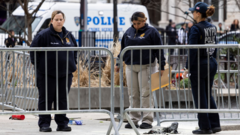
Maui Wildfires: What We Know About Cause, Search Efforts and Damages

U.S.|What We Know About the Wildfires in Hawaii
https://www.nytimes.com/2023/08/10/us/maui-wildfires-hawaii.html
The wildfires on the island of Maui are the deadliest in the United States in more than a century, with the death toll likely to rise still further.


A summer of ferocious weather across much of the United States has now yielded the nation’s deadliest wildfire in more than a century, 2,500 miles off the West Coast in Hawaii.
What began as scattered brush fires on the state’s biggest islands, Hawaii and Maui, turned deadly by the middle of last week. By Sunday evening local time, at least 93 people had been confirmed dead, and many on the island remain unaccounted for.
The rapid spread of the flames caught state officials and residents by surprise, and the Maui Emergency Management Agency estimated that it will cost $5.52 billion to rebuild in Maui County.
The death toll is likely to rise.
By Sunday the death toll had reached 93, making the fire among the worst natural disasters in Hawaii’s history, and the nation’s deadliest wildfire since a blaze in northeast Minnesota killed hundreds of people in 1918.
The fires have already taken more lives than a 1960 tsunami that killed 61 people on the island of Hawaii, also known as the Big Island, and the death toll could rise as rescuers travel to parts of the state that have been blocked by fires or by closed roads.
Dozens of people have also been injured, some critically. A precise death toll may not be known for weeks.
Image
What caused the fire?
No cause for the fire has been determined, but experts said one possibility was that active power lines that fell in high winds ignited the wildfire that ultimately spread to Lahaina, a coastal town of 13,000 in western Maui that was leveled.
Brush fires were already burning on Maui and the island of Hawaii on Tuesday. Those fires were stoked on Wednesday by a combination of low humidity and strong mountain winds, brought by Hurricane Dora, a Category 4 storm hundreds of miles to the south in the Pacific Ocean.
Multiple law firms have announced plans to represent fire victims, and one lawsuit filed over the weekend claims that Hawaiian Electric, the state’s largest utility and the parent company of the power provider on Maui, is at fault for keeping power lines electrified despite warnings of high winds. A spokesman for the company told CNN on Sunday that it does not comment on litigation but would work with the state and county as they review the fire.
Worsening drought conditions in recent weeks probably also contributed to the fire. Nearly 16 percent of Maui County was in a severe drought on Tuesday, according to the U.S. Drought Monitor.
The town of Lahaina suffered the most damage.
The fires were most intense along the western coast of Maui, which is generally drier and receives less rain.
Lahaina, once the royal capital of Hawaii, was devastated, and some residents there ran into the ocean to avoid the heat and flames. Survivors described fleeing for their lives from a fast-moving “total inferno.”
The fire in Lahaina damaged more than 2,200 structures — the vast majority of which were residential — and burned 2,170 acres, according to the Pacific Disaster Center, a research center managed by the University of Hawaii.
Image
Wildfires in the state are getting worse.
The area burned annually by wildfires in Hawaii has quadrupled in recent decades. Declining rainfall and rising temperatures have left the islands more susceptible to blazes, climatologists say.
Invasive grasses that are highly flammable have crowded out native vegetation in some areas, and climate change has exacerbated dry and hot conditions in the state, allowing wildfires to spread more quickly.
What’s next?
The Federal Emergency Management Agency said on Saturday that more than 150 of its employees were on the ground in Hawaii, including urban search-and-rescue teams and a canine search team, with more crews on the way. Canine teams have been able to scout only 3 percent of the disaster zone, according to officials said Saturday night.
The state’s transportation department said it would close a runway for general aviation at Maui’s main airport to accommodate cargo flights airlifting in goods and necessities.
Many residents who fled the fire were struggling to find gasoline, water and other essentials. An informal network of volunteers created an impromptu aid delivery system, but some residents were wondering why they had to rely on friends and private organizations for help rather than on government agencies.
Questions are also mounting about whether officials could have warned residents with more notice or evacuated them sooner. None of the 80 warning sirens placed around Maui were activated by the island or state’s emergency management agencies as the fire bore down on Lahaina.
“We are going to do some reviews so we can make things safer going forward,” Gov. Josh Green said.
Claire Moses contributed reporting.
Adeel Hassan is a reporter and editor on the National Desk. He is a founding member of Race/Related, and much of his work focuses on identity and discrimination. He started the Morning Briefing for NYT Now and was its inaugural writer. He also served as an editor on the International Desk. More about Adeel Hassan
Source: https://www.nytimes.com/2023/08/10/us/maui-wildfires-hawaii.html















